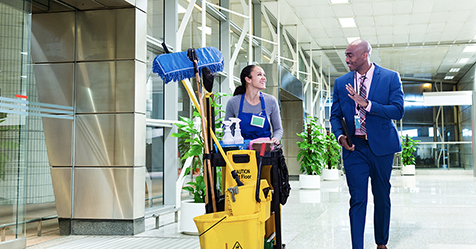The commercial cleaning industry has long adapted to change—from new technologies and client expectations to economic pressures. But few five-year periods have been as dynamic and defining as 2020 through 2024. A review of Building Service Contractor (BSC) Benchmarking Survey data from Cleaning & Maintenance Management (CMM) reveals how BSCs have navigated crisis, competition, and continuous transformation.
Staffing challenges persist, but are stabilizing
It’s no surprise that “recruiting and retaining staff” has topped the list of business challenges for BSCs every year since 2020. During the height of the COVID-19 pandemic in 2021, 63% of respondents said this issue affected their operations “to a large extent.” That number has since eased slightly—down to 57% in 2022 and 50% in both 2020 and 2024.
Although still a top concern, the recent data suggests a stabilization. Companies have adapted by improving pay, offering growth opportunities, and investing in onboarding processes. Still, workforce development remains a cornerstone of success.
“We hover around 91%–93% employee retention and that has consistently improved over the last five years,” said Channing Johnson, president of KB Building Services in Omaha, Nebraska. “I think it definitely has to do with increasing pay, ‘trying before we buy’ with a mandatory culture class before job offers, and showing—not just telling—during training.”
“I would also agree, even without exact figures,” said Jeffrey Upmalis, vice president of CNS Cleaning Company in Bristol, Pennsylvania. “We subcontract 100% of our labor, so while management turnover is low, younger subcontracted workers often need more hands-on training, or the relationship doesn’t work out. All the adaptations mentioned are things we’ve not only considered but implemented.”
Margins under pressure, but resilience is growing
Profit margins are another area of mounting concern. In 2020, just 31% of respondents saw maintaining profitable margins as a major issue. By 2024, that figure jumped to 39%, the highest of the five-year span.
What’s behind the pressure? Rising labor costs, increased demand for specialized services, and tighter contract competition. BSCs report that balancing quality service with competitive pricing remains a delicate equation—especially as clients push for both enhanced outcomes and cost reductions.
“Rising labor costs, specifically in Nebraska, have factored into a lower margin for sure,” Johnson said. “And a lot of customers—especially in the last three months—are being told to cut costs no matter what. So finding the balance of serving employees and customers exceptionally well, while retaining business, is a major struggle.”
“We do a lot of market research before pricing jobs,” Upmalis added. “While some areas have seen drastic price increases, others haven’t changed much. But consumables have skyrocketed. In places with little competition, like Maine, price gouging is common. For us, it’s a tug-of-war between margin and service—but handled as a partnership, not a battle.”
Bidding and customer retention are rising priorities
Interestingly, the challenge of “winning new bids and contracts” has grown steadily, from 29% in 2020 to 36% in 2024. Likewise, customer retention as a major challenge climbed from 22% to 31% during the same period.
This dual trend underscores a competitive market where differentiation matters more than ever. BSCs are investing in certifications, bundled services, and technologies to stand out in the bidding process and maintain long-term relationships with clients.
“Retention is what we preach,” said Upmalis. “We grow 35–55% annually, but last year we saw a net zero gain due to churn in small to mid-sized clients. We’ve now tied operations bonuses directly to retention and focus on the top 15% of our client base, which drives 85% of our revenue. Those relationships must be protected and deepened.”
“This is definitely one of my top priorities,” Johnson noted. “We’ve spent the last three years building custom software for better data transparency—and we average 99% customer retention. But pricing is sometimes all that matters now. I’ve lost bids with less than a 5% difference because decision-makers were told to go with the lowest price—something I hadn’t seen in 10 years until now.”
Automation gains traction—but slowly
While robotic and autonomous equipment was a hot topic early in the decade, adoption has been more cautious than explosive. Usage peaked at 19% in 2021, dipped to 13% in 2022, and hovered around 15% by 2024.
However, interest remains strong: over one-third of BSCs each year say they are “considering” adoption. For many, the hesitation lies in upfront costs and uncertainty about integration—not in the potential value.
“We’ve gone all in on technology,” Johnson said. “For me, that means better internal processes and less overhead. Smaller, more cost-effective robotic units are finally hitting the market, where ROI is visible sooner—which is key in janitorial, where you’re 30 days from being fired. My goal is to use automation and share savings with the customer to improve retention.”
“There’s a fine line between tech and labor,” Upmalis added. “We’re still far from full labor integration. But we use AI for research, Excel tools, and meeting prep. Some of our clients have fully automated warehouses—but they still require human oversight. I see automation as a support tool, not a threat.”
Labor costs inch higher
Labor costs consistently consume the majority of BSCs’ operating budgets, and the share of companies spending more than 70% of their expenses on labor has remained high—ranging from 23% to 27% between 2020 and 2024. This is driven by wage increases, competitive hiring, and rising expectations for service quality.
Some firms have offset these costs through better scheduling, smarter use of part-time staff, and time-tracking software. But the fundamental equation remains: Labor is still the backbone of the industry.
“We work closely with subcontracting partners nationwide,” said Upmalis. “We use annual increases to stay ahead of inflation and even terminate contracts if terms don’t align. Subcontractors are like mercenaries—you have to find the right match and ensure it is profitable for them too. Our focus is mutual success.”
“In Nebraska, minimum wage is rising from $9 in 2022 to $15 in 2026,” Johnson said. “That shifts the whole pay scale. You have to pay more for high-quality, long-term employees. So we’re focused on creating efficiency through better specs, processes, and equipment—because the wage is what it is, and many customers don’t understand or care.”
Sustainability emerges as a serious differentiator
One of the most striking shifts between 2022 and 2024 is the emphasis on sustainability and environmental, social, and governance (ESG) reporting. In 2022, just 24% of respondents said customers required ESG reporting. By 2023, that rose to 31%, and while it dipped slightly in 2024 to 26%, the number of BSCs using ESG to attract customers or employees grew from 29% to 41%.
Government, healthcare, and education clients are most likely to demand sustainability transparency. Forward-thinking contractors are responding with green certifications, waste reduction plans, and carbon footprint tracking.
“I disagree here,” Johnson said. “Most companies say sustainability is a priority because it looks good—but less than 5% of my clients actually discuss it, especially if it costs more. We’re CIMS-GB [Cleaning Industry Management Standard-Green Building] with Honors certified, and I have my LEED [Leadership in Energy and Environmental Design] Green Associate, but I’ve had fewer than five real sustainability conversations in eight years.”
“We jumped into this during COVID,” said Upmalis. “We used nanotechnology that killed 99.1% of bacteria and viruses with no return visits. It was cost-effective, safe, and sustainable. But today, cost remains the No. 1 factor in decision-making. Sustainability is rarely a dealbreaker—it ranks third or lower in most RFPs [requests for proposals].”
The adaptable contractor thrives
The data tells a clear story: the BSCs that succeed are those that adapt. Whether it involves navigating the tight labor market, sharpening bidding strategies, exploring automation, or aligning with clients sustainability goals, today’s contractors must be both resilient and proactive.
While the post-pandemic years have been anything but easy, they’ve revealed a critical truth—building service contractors are more than cleaners. They are essential partners in facility health, safety, and sustainability. And as the industry continues to evolve, so will the strategies of those committed to leading it.
“Being innovative, thinking outside the box, and being first to the apple cart is key—and way easier said than done,” Johnson noted.
“Consistency and relationships matter most,” Upmalis concluded. “Reputation, results, and being more than just a B2B vendor—that’s the key to long-term success. Adaptation helps, but the basics still win.”
Editor’s note: You can access all CMM surveys on the Industry Research page.


